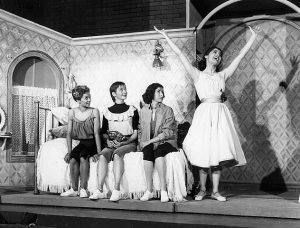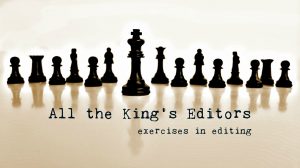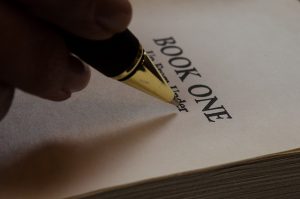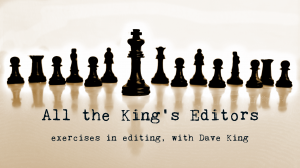Editing
Yes, I know, Tony Curtis never actually said the line. But does sum up one of the problems this morning’s editing is trying to address – language that is meant to create a mood of fantasy and wonder and instead simply comes across as formal and forced.
First, a caveat. This passage is taken from a ways into the story. I’m assuming that many of the questions that naturally come to mind – who and what the air-travelers are, how they arose so soon after a nuclear holocaust, how prophesies work in this world – are answered by what came before.
But even with that caveat in mind, we can pinpoint a mistake common to fantasy writers. Most fantasies take place in worlds based roughly on the middle ages, with swordfights and alchemy and yonders dotted with castles. In trying to create a language that fits that kind of world, many fantasy authors come up with an amalgam that is simply stiff. Contractions tend to disappear, for instance, answers nearly repeat the question (“Are you The One?” “I am not The One.”), and word order is reversed often for no reason apparent.
It is possible to write in a language that feels genuinely medieval, with a rhythm and emphasis different from what they are today. But in this case, the story is set within living memory of the present. Senior (a character’s name) was an adult when the bombs fell, and both books and some technology, which doesn’t seem radically different from modern technology, have survived. The language wouldn’t have had time to evolve much, so it makes sense to simply have the characters speak a colloquial, modern English.
Keeping the language colloquial also helps with a second problem – the author isn’t getting into Great’s head as well as she should. Great (the main character) is apparently going to give up being an air-traveler in order to help the people of Liberty. In order for readers to understand what that sacrifice means to her, they need to know more of what it feels like to be a traveler. They need to know, at a visceral level, what she’s losing.
Read MoreMy last post discussed nonverbal communication (gestures, expressions, posture) as a means of making scenes stronger, less repetitive, and more immediate. This blog will explore how non-verbal communication provides a means of incorporating backstory seamlessly and integrally into a work of fiction.
Backstory–where the characters have come from, what they have experienced, how they have successfully or unsuccessfully reacted to their past context–is an essential, critical, and desperately difficult element of successful storytelling. Done poorly—in ‘data dumps’, tell-all prologues, or extensive and jarring flashbacks–it pulls the reader backwards, out of the motion of the story and into a closed off past. Done well—integrated into the story–it pulls the past forward, providing clues to the way a character’s past experiences and disappointments influence present choices, actions, and mistakes.
How to integrate backstory into the story present is neither obvious nor easy. There are many writerly devices to do so—through direct communication (characters discussing the past, a character’s internal self-examination, or a narrator’s overview); through discovered records (letters, diaries, photographs), through story consequences from past actions (scars, physical injuries, institutionalization). Many of these devices require a good deal of finesse to make them a believable part of the story rather than a ‘plant.’ Would those characters really have had that conversation about the past? How convenient that the letter explaining everything was found within two pages of the conclusion. Readers are smart, and any time these writerly devices start to feel like authorial manipulation—a lazy means of communicating story information–rather than an integral part of the story, the reader loses a little faith.
Nonverbal communication–which is based on learned, repeated, or automatic responses developed from past experiences–provides a powerful story tool for connecting the present to the past in a manner that can minimize this sense of manipulation. Nonverbal communication offers immediate, visceral information to the reader; often information that the character would not willingly tell; and always information that brings the past into the present. This makes it possible for a writer to incorporate backstory as a part of the present story action, without resorting to exposition, explanation, or ‘telling.’
When a nonverbal reaction is normal, when it matches expectations, it is close to invisible. When it is unexpected or inappropriate it is glaringly visible and creates powerful story questions. Readers (and other characters in the story) instinctively understand that anomalous reactions require examination and explanation. Imagine a character whose reaction to a friend’s tear-filled apology is narrowed eyes and crossed arms. Why did she do that? The reader will typically assume that the answer lies in the character’s past–that at some point her unconventional reaction was a successful response, not an awkward one.
Emojis (which are literally a graphic alphabet of non-verbal communication) demonstrate the visceral power of inappropriate nonverbal response. Have you ever left the ‘wrong’ emoji in reaction to a text or a post? A thumbs up on a friend’s announcement of a deceased pet? A crying emoji when everyone else’s emoji is angry? Have you ever felt like you need to explain that discrepancy? Or delete it? Or edit it? That is the power of the unexpected response.
Read MorePhoto by Joshua Fuller on Unsplash
I had the chance to visit a class of undergraduate advanced Fiction Writing students this week. It was delightful—I remember being an undergrad, having authors come into our classroom, sit at a desk, and just chat with students. It always felt like such a privilege to gain insights into their writing process, and it was absolutely a privilege for me (some 13 years later) to be able to share my experiences with them.
These being writing students, their questions were so different from those I get at Q&A sessions with readers. They were incredibly specific and craft-focused.
Here is a rendering of me every time I am initially asked a craft question:
Shrug emoji. That’s all that goes through my mind. Because at first thought, I don’t really know how I did xyz in a specific scene or throughout the narrative. I know it was difficult. I know it didn’t just happen. I know I knew enough to sense something was off on the page and that I needed to fix it until it was right. Craft is hard work, but it can also feel like magic. It’s subtle enough to feel instinctual, when it’s really the deeply engrained benefits of practice and experience.
In other words: when I’m asked a question about craft, I inevitably end up describing revision. Because I’m not a writer who gets everything right the first time. I’m not even a writer who gets everything right the second time. Except for the occasional scene that has manifested more or less in its true, final form (again: magic!) I am very much a reviser.
When I was an undergrad, my Creative Writing teacher once told us: the first draft is self-expression, the art is in revision.
I embrace that wholeheartedly in the writing process. I write a first draft with no real plan or outline, then I step back halfway through and try to piece together what I might be saying. Sometimes at that point, I’ll outline the rest of the story, but it’s only once a first draft is done that the real work can begin.
For me, revision starts very organically and gets progressively more strategic with every subsequent draft. But in the beginning, I just feel my way through a story. Some ways I do that include:
Read MoreWhy are you here? What is your purpose? Would anyone notice or care if you disappeared forever? If you fail to make a compelling case for your existence, you will be exterminated.
This is not the first scene of a dystopian novel. These were my opening statements when I put every chapter, sentence, and word of my novel manuscript on trial. If my words could not defend their space on the page, I handed down the maximum penalty: I deleted them.
To be fair, I stole this revision strategy (or a version of it) from author Chris Castellani (Leading Men, Viking 2019). Chris borrowed it from Francine Prose’s book Reading Like a Writer, where she attributes the advice to put “every word on trial for its life” to an unidentified friend. Good advice, it seems, is meant to be passed on.
For me, it all started, as most good things do, in the drawing room of a haunted thirteenth-century Irish castle. In June this year, I gathered with several other GrubStreet writers, including Chris Castellani and Alice Hoffman (Faerie Knitting: 14 Tales of Love and Magic, Simon and Schuster 2018) for a writing retreat.
As we worked in Kilkea Castle, one of the most haunted castles in Ireland, Alice challenged us to write a ghost story. Alice Hoffman, who I’ve always suspected has secret supernatural abilities herself (have you read The Rules of Magic and Practical Magic?) has this gentle, unassuming way of teaching. She sat with us on the comfy castle couches and wrote alongside us while we nibbled on scones, sipped tea, and explored our darker writing selves.
During Alice’s workshop, I developed a fully formed ghost story. I liked it, but it needed work. As a novelist, I usually write longer pieces and wasn’t sure how to revise my very short ghost story or if I even wanted to.
The following day, in that same drawing room, Chris led a workshop and challenged us to put every word we wrote on trial. That seemed a bit extreme. My novel in progress, a literary thriller, was 99,000 words at the time. How could I possibly put every one of those words on trial?
But my ghost story? It was only 1,000 words. That night I took Chris’ advice and put my ghost story on trial. Every single word. Why are you here? I asked each word. What is your purpose? I whittled it down to a 700-word flash fiction piece.
Our final night in Kilkea Castle, we all gathered around a fire in the dungeon, sipping wine and Irish whiskey, to share what we had written. I read my ghost story. It felt muscular and lean because I had burned off so much unnecessary language. I liked the growl and rumble of tight sentences.
But could I do that with an entire novel?
After I returned home from Ireland, I set a court date. I channeled Chris’ enthusiasm and put my entire novel on trial. For the first round of questioning, I called each chapter to the stand. (Please bear with me. I’m really enjoying my extended courtroom metaphor.)
What is your purpose? The answer on the chapter level must relate to plot. Does this chapter or scene either move the plot forward or fundamentally develop […]
Read MoreLast May, the opening scene I edited raised a lot of questions – about the characters, their relationships, their backstory – without answering them right away. Of course, no opening scene can tell you everything at once, but this one put questions out there and then moved on, leaving readers hanging. This led one commentator to ask about ambiguity and what to do about it.
A quick survey of writing about writing shows that most of the advice you get on ambiguity is on how to get rid of it. I’m not so sure this is wise. Ambiguity can often be a powerful storytelling tool.
Understand, I’m not talking about misdirection, where your readers think they know what’s going on but eventually discover that you’ve been misleading them. And I’m not talking about clear plot questions that readers don’t yet know the answer to – “whodunit” is not a matter of ambiguity. I’m talking about the kind of scenes were readers have no idea what the scene means or why it’s in the book, and the writer knows that readers will feel that way.
You often have no choice but to include some ambiguity in your opening scene, especially if you’ve created a complex world or characters with full, interesting histories. The alternative is to try to convey all that background before the story begins—and weigh down your hook with a lot of exposition. It’s usually much better to simply trust that your readers will keep reading even if they don’t understand everything that’s going on.
Last February, we looked at a YA story set in Ghana, in which the narrator’s mother cooked a chicken that the narrator had considered a pet. One comment raised the question of why the mother did this. I pointed out that the rest of the village also seemed to be involved in the meal, which meant that the mother’s motives probably involved a skein of social obligations that western readers wouldn’t understand without a lot of explanation. But getting into the weeds of the mother’s decision at that moment would have drawn attention away from the narrator’s reaction to losing her chicken, which was the emotional core of the scene. The author had little choice but to leave the mother’s motives up in the air for the time being.
In trying to avoid this kind of thing, writers often choose an opening scene that is entirely self-contained and clear. And this can sometimes work. But it often means avoiding what’s most interesting about your world in your opener, since the things that make your world unique are also the things that make it engaging. Besides, you can often draw readers into your story if you leave them wondering just a bit about what’s going on. This is particularly true in science fiction and fantasy, where readers don’t expect to understand everything right away, or in spy thrillers, where readers expect that things won’t make sense until all is revealed.
Read MorePhoto by Nolan Issac on Unsplash
There are so many in-between phases in the writing life.
There’s the time before you begin writing a story, but have already felt the beginnings of a story simmering inside you.
The time between finishing a draft and revising it.
The time between finishing that draft and revising it yet again. (Repeat as necessary.)
The time between finishing a story and starting a new one.
What do you do with that in-between time? I’ve discovered this must be what non-writers call hobbies. Things that bring you joy, that you do purely for fun and pleasure. Which isn’t to say that writing is not something that brings me joy or that brings me pleasure…it’s just that I don’t quite see it as a hobby so much as a part of my life. Like breathing and reading.
I’m learning that the most nurturing hobbies for me are the ones that allow me to turn off my writer’s brain for a bit. Walking through my house the other day, I realized something.
Read MoreToday marks the paperback and audiobook release for The Moon Sisters–a book that earned some critical acclaim, but not before nearly dying on the vine, pre-publication. Below is one story behind the story, complete with rising stakes, a ticking clock, a dark moment, and a turning point.
THE SETUP
I had been working on The Moon Sisters for ~4 years, as the publishing ground shifted radically beneath me. The imprint at Random House that had signed me to a 2-book deal had been shuttered, and I had been shuttled to an imprint about to change its mission statement. My original editor was with a different house. My 2nd editor, too, left for a different house. My 3rd editor also left, after providing me with comprehensive editorial notes about a year prior to the start of this tale. My 4th editor, therefore, inherited the story, its old editorial letter, its revision, and its somewhat rattled author.
This is where the story starts.
A WRITER’S GOAL, MOTIVATION & CONFLICT
I received notes from Editor #4 in early March, wherein she kindly acknowledged how far the story had come with regard to Editor #3’s notes, and roundly encouraged the story in many heartening ways. But some important issues remained for her, and as I worked through the letter, I homed in on one gigantic problem:
Editor #4 was not onboard with the PREMISE of the novel, which was, briefly, “Two sisters travel to a cranberry bog in West Virginia to find the end of their recently deceased mother’s unfinished novel.”
Her clarified point, Why should readers care if the sisters get to the bog and meet their goal?, was hard to hear, because I cared about my protagonists and understood their dreams. They were worth caring about.
My goal became to find the proof of it.
RISING TENSION, A TICKING CLOCK & A DARK MOMENT
We all have strengths and weaknesses, as writers and as people. Something I consider a personal strength is being an ‘ideas person.’ I can mentally slide everything onto the bubble, then experiment to see how one aspect or another of my story might be reimagined. I don’t shy away from revisions if they are needed; I completely rewrote my first novel in another genre, for instance, before it sold. But every time I considered a new spin for the premise of this story and visualized how that spin would play out through the end of the book, the narative fell apart at some crucial moment.
Weeks passed, and still I had no workable solution to this problem. Meanwhile, the tick-tick-tick of the clock began to haunt me. I had through July to send in the next draft, and my deadline had already been pushed once. I had to find a solution, and leave myself enough time to execute it. But as night set on one solution-less day after another, a sickening possibility took hold: There may not be a solution, and the book might never be published.
AN IRONIC ASIDE
Maybe you’re thinking, “How ironic! The story is about finding the end of this dead author’s story, and this author thought she was going to die trying to figure out how to save her own story.” Mmhmm. The Moon Sisters is, at root, a story about a journey to preserve hope, […]
Read MoreThis post is the next in the ‘All the King’s Editors’ series, the brainchild of WU contributor Dave King. In this series, WU contributors edit manuscript pages submitted by members of the larger WU community, and discuss the proposed changes.
This is intended to be an educational format, and we hope this exercise will generate useful comments about the proposed changes–why the editorial suggestions do or don’t work.
Interested in submitting a sample for consideration? Click HERE for instructions.
* * *
Hello, everyone. Time once again for me to step into the editor’s chair. The following story is intriguing and well written with a strong, distinctive voice, and I think this writer is clearly capable enough, with another revision or two, of making this a fascinating story.
I have only a few line edits given the writer’s competence — largely punctuation (commas vs. semicolons) and capitalization (“Momma” when used as a proper name). Most of my other edits are cuts, where I thought the writer was either explaining too much or providing information that was better left implicit, rather than made explicit.
My principle focus will concern approach, specifically tone and perspective, and I’ll address all of that after the story itself.
Here we go:
* * *
My momma is a healer. She heals lost souls.
We live in a huge building with a doorman who holds open the door and leads us into the elevator. He even walks us to our apartment and opens the door with a special key. Momma gives him some money when he does this and he bows at the waist like in the old movies.
I go to a private school now. , mMomma says it’s important that I learn as much as I can ‘cause she don’t want me to turn out like her. That doesn’t make sense to me. I think she’s just grand. She’s beautiful with her bright red lips and her spiky heels and silky dresses. Her hair is black and shiny and it smells like Aqua-Net. It’s never out of place. Everywhere we go people stop and stare. I see them whisper and point. They must really think she’s something too.
Our life wasn’t always like this. There was a time when we didn’t have much to eat, ; when we lived in a small apartment, and slept on a mattress laid out on the floor, and ate our dinner out of a bag. I think that’s when mMomma was training for her job, before she learned how to dress and act. That was before she learned to make herself pretty, to put on her makeup and nice dresses and heels. But she studied real hard, she read magazines and watched the women on TV. She learned how to walk straight with her head in the air. I would giggle when she walked around with a book on her head but she got real good at it and now it hardly ever falls off.
Sometimes we would practice manners. She would set the table with plastic silverware and paper plates and cups and we would practice […]
Read MoreThe writing life is a whole shit-ton of guessing and experimenting and hoping, and then finding someone to tell us that we stink in some places and are pretty brilliant in others.
Knowing what prose to keep and what to toss is subjective—at least until your readers read your published book, then subjection goes all out the window and into space-ace-ace-ace. Having an editor and perhaps a trusted and very-truthful-even-if-it-hurts friend/colleague is super important—for everyone, everyone, EV-ER-EE-1 (and I’ve learned this lesson the hard way).
But you have to listen and apply. After your beautiful perfect book has been ripped asunder, go to bed and yank the covers over your po’ wittle pea-head for an hour or two or twenty and then pull up your big boy undies and your big girl panties and suck it the hell up! There likely isn’t a one of us who hasn’t been scathed and burned and shredded by an editor and/or trusted colleague/friend. If you climb down off your high-horse, you can better see the piles of poo that need cleaning up so your horsey can freely gallop. And your manuscript will be the better for it. I done climbed (been bucked) off’n my high horse a time or two, by golly! And I’ve done some burning and scathing and shredding of other writers’ manuscripts. (I say this to my personal training client but it applies to the editor-writer relationship: hate me today; love me tomorrow!)
Have you ever watched deleted movie scenes and thought, “Glad they took that out!” Imagine if those deleted scenes were still there. We may think, “That’s really out-of-left-field/silly/doesn’t make sense/over the top/ boring/self-indulgent . . . .” (Sometimes Me thinks about some long movies, “Should’a cut some of this danged ol’ movie . . . ungh.”)
But because things can never be easy (insanity! Insanity! Insaaannity!) maybe a deleted scene is great and you may think, “Hey, that’s a cool scene; why’d they take it out?” Sigh.
But folks, really, no one notices the place the deleted scene(s) once occupied—and they have a reason for taking it/them out, right? Even if only because Big Movie Head says, “This thang is too long. Cut it or I stop paying the bills.” We moviegoers are unaware of all that work and cutting and drama—which is how it should be.
Here’s what happened with one of my novels that I’m most proud of (Sweetie): I’d given the manuscript to my editor the evening of my deadline and the very next morning I contacted her in a panic, retrieved that manuscript back from her, and immediately deleted 2 chapters up front, 2 chapters at the end, and rewrote a good portion of that manuscript at.the.very.last.moment. I shudder to think of what Sweetie would have been without my last minute deleting and reworking. And, really, I knew it before I sent it, but didn’t listen and apply my own instincts, until, of course, I did. I love that book and so did (do) many readers.
Be true to who you are but perhaps, she gently says, stop trying so hard to: show people what a Writer you are; that you can write like/better than […]
Read More
This post is the next in the ‘All the King’s Editors’ series, the brainchild of WU contributor Dave King. In this series, WU contributors edit manuscript pages submitted by members of the larger WU community, and discuss the proposed changes.
This is intended to be an educational format, and we hope this exercise will generate useful comments about the proposed changes–why the editorial suggestions do or don’t work.
Interested in submitting a sample for consideration? Click HERE for instructions.
* * *
Hi friends. I am happy to share this submission today as it gives us the opportunity to examine memoir, an oft-misunderstood genre. I oft-misunderstood it myself until I began working with two critique partners, both of them memoirists. As it turns out, memoir and fiction are as similar as (fraternal) twins!
First let’s look at the submission from chapter nine of OUTLASTING ANGIE, the moment during which the narrator receives a terrifying diagnosis.
Notes of clarification from the writer:
1. Sean is my brother.
2. There are three surgeons (introduced earlier in the MS) mentioned in this excerpt: Dr. G, a brain surgeon; Dr. L, another brain surgeon I saw 11 years earlier; and Dr. T, my primary care physician.
The Submission from Chapter Nine:
“You have a cavernous angioma. It’s on your brain stem.”
Dr. G rolled his chair back and angled his computer monitor toward me and Sean. He pointed to a series of images—my skull, in two-dimensional slices. The local hospital had emailed my latest MRI scans several days prior. I looked at my left and right brain lobes. Saw my eye sockets. Nasal cavity. He held a pen to the screen, hovering over layers of gray, and traced the single black mass in each, just right of center. The part that shouldn’t be there. The part they said had grown by nearly two centimeters.
“You have a cavernous angioma,” he said. “It’s on your brain stem.”
A … what? I thought. What’s he talking about? I have a calcification. A calcium deposit.
Dr. G rolled his chair back and angled his computer monitor toward me and Sean. He pointed to a series of images—my skull, in two-dimensional slices. The local hospital had emailed my latest MRI scans several days prior. I looked at my left and right brain lobes. Saw my eye sockets. Nasal cavity. He held a pen to the screen, hovering over layers of gray, and traced the single black mass in each, just right of center. The part that shouldn’t be there. The part they said had grown by nearly two centimeters.
He spoke to me and Sean in a windowless exam room, telling us what I had and what it could, and already was, doing to me. Yet, he called it something else. Not a calcification. A neurovascular disease. A cavernous angioma.
“Pathological yawning,” the doctor continued, “can be a clinical sign of a disorder affecting the brain stem,” Dr. G explained. You’re also presenting with persistent hiccups—chronic for days, you said, yes?”
“Yes,” I confirmed.
“Persistent hiccups, those lasting at least forty-eight hours without stopping, can lead to what is called intractable hiccups, those. Much more serious. Intractable hiccups are those that last a month or more without stopping. Clearly, […]
Read MoreJim’s post is part of the “All the King’s Editors” series where an editor from the Writer Unboxed contributor team edits manuscript pages submitted by a member of the WU community.
Each participating editor will approach a submission in a unique way, and speaks only for him or herself.
Remember, editing is as much art as science, and your take on the passage may differ. If so, feel free to join in the discussion at the end, but above all, be kind.
If you’re interested in submitting a sample for consideration, click HERE for instructions.
These pages are from the second chapter of this novel, and for me they set the tone and place of the story perfectly—a light, funny paranormal tale set in California.
Two things struck me about this text. One was how the author gets in the description of the first person narrator and then how you can gain—or lose—the readers’ trust through breaks in story logic. Look out for these as you read, and I’ll explain more in my numbered notes at the end.
I made very few changes to the text as these pages looked pretty polished. Most of my revision suggestions would need more input from the author, but it wouldn’t take much to get these pages into great shape.
Read MoreThis month we’re once again looking at an opening passage. The situation certainly tense enough – a woman with two small children facing up to her need to escape from a physically abusive husband. And the author makes skillful use of her techniques to create that tension – note how the narrator, Nikki, is sensitive to every time Jake touches her.
But the author also gets in the way of the drama of the situation in a couple of different ways. So take a look at the editing and judge for yourself. I’ll offer my own comments below.
As always, you’re welcome to submit your own work to The Writer Unboxed stable of editors. You can find the guidelines here.
The house lights dimmed. The curtain lifted. [1] He Jake still hadn’t arrived by the time the houselights dimmed and the curtain lifted. If he would only stayed away, Nikki might would have a chance to gather her strength, to think. She nuzzled Seth’s baby fine hair as he cuddled on her lap, his small hand twisting her long brunette hair for comfort.
The opening chords of the “Sugar Plum Fairy” played, and on stage, her pretty little daughter, Kasey, led the four to six-year-old girls, all dressed in sherbet-colored tutus across the stage. AThe girl in the lime tutu turned the wrong way, and dear Kasey stepped out of line to push her back into place, quickly returning to her spot to continue the routine. She had Jake’s outsized confidence.
Read More



















